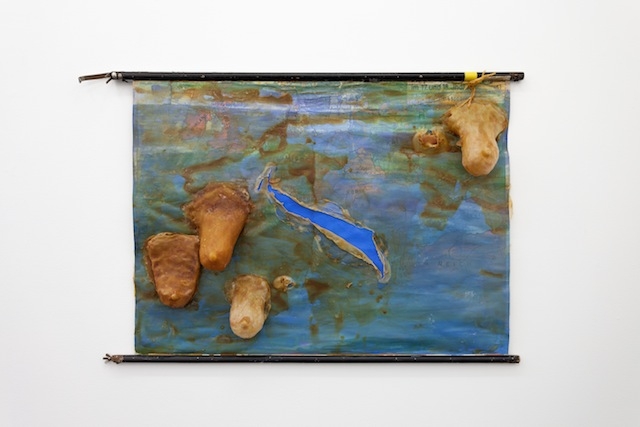Koppe Astner, Glasgow, 21 April – 27 May
Ewig Weibliche is a small exhibition of works by Darja Bajagić, Olga Balema, Charlotte Prodger and Benedicte Gyldenstierne Sehested. The title refers to the notion of the ‘eternal feminine’ and was important to Goethe. To varying degrees the exhibition attempts to contest this idea, examining gender essentialism, sexuality and archetypal feminine ‘virtues’.
That said, Prodger’s video sculptures fit less easily into this schema than does the work of some of her fellow exhibitors, though there are elements of fetishisation here that appear at various points across the works of the four artists. In her Forest Hills/Oregon Dacite (2013–16), the fetish in question – a recurrent motif in Prodger’s work – is sneaker-slave subculture, aka trainer porn. On one of two monitors (the other showing extended, detailed flint-knapping to form an arrowlike tool), an anonymous YouTuber, shown lower-torso only, scrapes and scuffs a pair of pristine white Adidas trainers against rocks and stones, grating them into dried mud and rubble. This is abject art for millennials. The artist’s audio overlay – recounting remembered fragments of the formation of Prodger’s queer identity – offers more substance, rupturing any potential for a holistic narrative through disjunction between what we see and hear, and posing subjectivity and lived experience as a political act.
The disturbing, childlike figures in Sehested’s untitled pair of sculptures (2016–17) could be props from an Aphex Twin video. With disproportionately large hands and heads, blankly expressionless faces and awkwardly jointed limbs, they stand and sit on the gallery floor, lifesize bodies shrouded in semiopaque gauze and cotton over a galvanised metal armature. In one of the two works, a smaller figure sits on the lap of another, larger ‘child’ wearing a wig. Here, the ‘come to daddy’ sexual associations we project onto these creatures become the most unsettling aspect of the work.
A cluster of latex breasts hangs from one of Balema’s two large, overpainted school wall-maps. In Motherfucker and Everybody and their mother (both 2016) the artist makes parodic allusion to the stereotypes of mother earth and the nurturing female body. Only glimpses and shadows of certain countries remain beneath. Territories and empires are obscured by a thin, almost transparent skein of latex and paint, and suffocated by multiple fleshy protuberances. Perhaps these breasts are intended as a matriarchal palimpsest, an aggressive reclaiming of established (male) world history? These associations aside, the disembodied breasts are also grotesque, a kind of horror-movie skinsuit, or lumps of stretching, pulling flesh from John Holmes’s iconic cover for Germaine Greer’s The Female Eunuch (1970).
Bajagić’s work, sourced from social media, news and pornography, purports (according to the press release and in interviews with the artist) to juxtapose ‘happy, sexy and friendly’ imagery with ‘darker’, more nightmarish visual references to murderers and serial killers. For me, there’s nothing of the former and not much of the latter (the true-crime element isn’t apparent just from looking). Rather, these seem like the routine art/porn collages of a million degree shows, assumed by the artist to be shocking but too derivative for impact. In an exhibition that is framed as one which rejects gender essentialism, a concentration on the physicality of gender in some of these works seems a little dated in an era focused on gender fluidity and postbody politics. And while the show as a whole often asks important questions related to gendered identity, if there is sophisticated critical content underpinning Bajagić’s work, it’s buried with the bodies.
From the Summer 2017 issue of ArtReview
